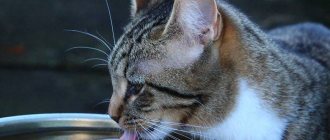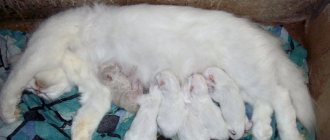Cat flu is an inflammatory disease of the upper respiratory tract, which without appropriate treatment causes complications. The prolonged form weakens the animal’s body and often leads to death. This disease does not pose any danger to humans and other animal species, but felines can easily become infected through close contact.
What is the flu in cats?
Cat flu is a viral disease and there are several causative agents. The form of the disease and its severity depend on the strain of which virus is the cause:
- feline calcivirus - if treatment is prescribed at an early stage, the disease is mild. It is mainly accompanied by discharge of fluid or mucus from the nose and frequent sneezing. In its advanced form, it affects the oral cavity, numerous ulcers appear on the tongue and mucous membranes;
- rhinotracheitis or feline herpes - the disease is more severe, affecting all respiratory organs, including the lungs. A distinctive feature is that the eyes are damaged. This is manifested by lacrimation, ulcers on the cornea, and purulent discharge. Often complicated by throat diseases.
There are other strains, but they are less common. The cat flu they cause has similar symptoms.
Calcivirus
The symptoms of this pathogen are virtually the same, but the course of the disease is milder, the body temperature does not rise much, and there may be no chills.
In this case, you also need to seek help from a specialist who will conduct an examination, collect tests and prescribe appropriate treatment.
- Please note that cat flu is significantly different from human flu.
- Self-medication is under no circumstances allowed, because self-prescription of the drug can not only delay the pet’s recovery, but also aggravate the situation.
It is also worth paying attention to the fact that small kittens with an advanced stage of influenza can develop pneumonia and arthritis, which can be treated.
How does infection occur?
Cat flu is most common:
- in stray cats;
- in animals that are often outdoors;
- those living in one room in numerous groups.
To a greater extent, the virus attacks kittens, old cats, and animals with weakened immune systems and chronic diseases.
Healthy, strong cats with good immunity are also susceptible to infection, but their disease is milder.
The virus is transmitted through close contact with other individuals through airborne droplets. This happens during joint games, when using a common bowl for eating or drinking. The virus is quickly destroyed in air, but cases of transmission of infection through bedding, toys or care items have been observed.
The likelihood of infection can be reduced by carrying out disinfection measures in cat habitats. The virus is easily destroyed by treating the room and cat's belongings with a weak bleach solution.
FAQ: We answer frequently asked questions
Is cat flu dangerous for humans? No. A person cannot become infected with cat flu - the disease is not transmitted and does not pose any threat to the health of the owners, so treatment of pets is carried out on an outpatient basis.
What animals are at risk? At risk are unvaccinated cats, pets with immunodeficiency or weakened immunity, as well as kittens under 6-8 months and older cats. Pets living in nurseries are identified as a separate risk group.
Can a domestic cat get cat flu? Yes, even if the pet does not go outside and does not come into contact with other animals, there is a risk of infection - viruses can be brought with them by owners from the street (for example, on the soles of shoes or outerwear).
Symptoms
The disease has an incubation period that lasts up to 10 days, but symptoms may appear as early as the second day after infection.
Main features:
- any form of conjunctivitis, eye ulcers, dried purulent crusts;
- nasal discharge, sneezing, congestion, in advanced cases - thick purulent discharge;
- lack of appetite due to loss of smell;
- salivation;
- ulcers on the lips and in the oral cavity, on the nose;
- weakness, fever.
If the disease is not treated, a complication occurs, which is characterized by inflammatory processes in the throat, pneumonia, dehydration and exhaustion. The possible outcome in this case is the death of the animal.
The above symptoms can be pronounced, or they can be almost invisible. There may be only one symptom present or several at once.
If at least one sign appears, you should consult a doctor. It is important to correctly diagnose, exclude other diseases, and begin treatment.
Diagnosis and treatment
A qualified specialist often identifies cat flu by symptoms and prescribes treatment without special examination. Sometimes, in order to clarify the diagnosis, additional diagnostics are performed. This is necessary in advanced cases, when signs of a secondary disease are pronounced.
The type of virus is determined by examining discharge from the nose or eyes. Determination of the virus is possible through a blood test using a PCR (polymer chain reaction) test.
A sick cat must be protected from other relatives and placed in a warm room without drafts.
How to relieve symptoms and treat cat flu - all therapeutic measures and medications should be prescribed by a veterinarian. Medicines for humans are not suitable for cats. In addition, the dose of all medications should be selected depending on the age and weight of the animal.
The principle of treatment is as follows:
- to increase immunity in a sick animal, immunomodulators are prescribed;
- to eliminate symptoms (conjunctivitis, runny nose, oral diseases), drops, ointments, and sprays are used;
- carry out antiviral therapy;
- at high temperatures, animals are given antipyretics;
- If secondary diseases occur, antibiotics are prescribed.
The cat's owner must follow all doctor's instructions. Only complex therapy will alleviate the pet’s suffering and speed up recovery.
If the cat refuses to drink, you will have to force him to drink to prevent dehydration. Water can be injected into the oral cavity using a syringe without a needle or a small syringe. Be sure to do this in small portions so that the cat can swallow the water. Water will pour out of the mouth in large quantities.
Often with cat flu, the cat refuses food. This is due to the fact that his nose is stuffy, and therefore there is no sense of smell. In this case, it is necessary to include in his diet foods with a strong smell: fish, liver, cottage cheese or flavored food. Warm food smells stronger than cold food. If you completely refuse food, you will have to take IVs to prevent exhaustion of the body.
After recovery, some cats become carriers of the virus. To exclude infection of other pets, you need to check with your doctor which strain caused the disease and whether the cat can be allowed near other pets.
Diagnosis of the disease
Symptoms of influenza in cats are similar to a number of infectious diseases.
- It is worth considering that the flu affects the upper respiratory tract, which can be clearly heard at an appointment with a specialist.
- Based on the examination and test results, the doctor prescribes the appropriate type of treatment.
If the information received is not enough, the specialist may prescribe additional examinations and tests, this will allow a more accurate determination of the type of pathogen and the optimal approach to treatment.
Prevention
Preventive measures include:
- Vaccination is recommended even when the cat is indoor and never goes outside. Vaccinated pets may get the flu, but the disease will be mild and without complications;
- regular disinfection of cats’ habitats and household items;
- maintaining immunity: proper nutrition and timely treatment of other diseases.
When the first signs appear, you should immediately contact a veterinary clinic. Timely treatment will prevent complications from occurring.
Causes of infection
The disease can develop if the following viruses enter the animal’s body:
- Calicivirus (Feline calicivirus). Affects the upper respiratory tract. Both domestic and wild individuals can become infected. Can be compared to the human cold.
Herpesvirus (Feline Herpes Virus) or rhinotracheitis. The infection spreads through the respiratory tract throughout the animal's body. In addition to breathing problems, it affects the organs of vision. Often has complications, accompanied by a bacterial infection.- Chlamydia Chlamydophila felis. Acts as a pathogen in cases of weak immunity.
The disease can also occur with the development of concomitant diseases that influence the development of the disease - obesity, leukemia, immunodeficiency.










